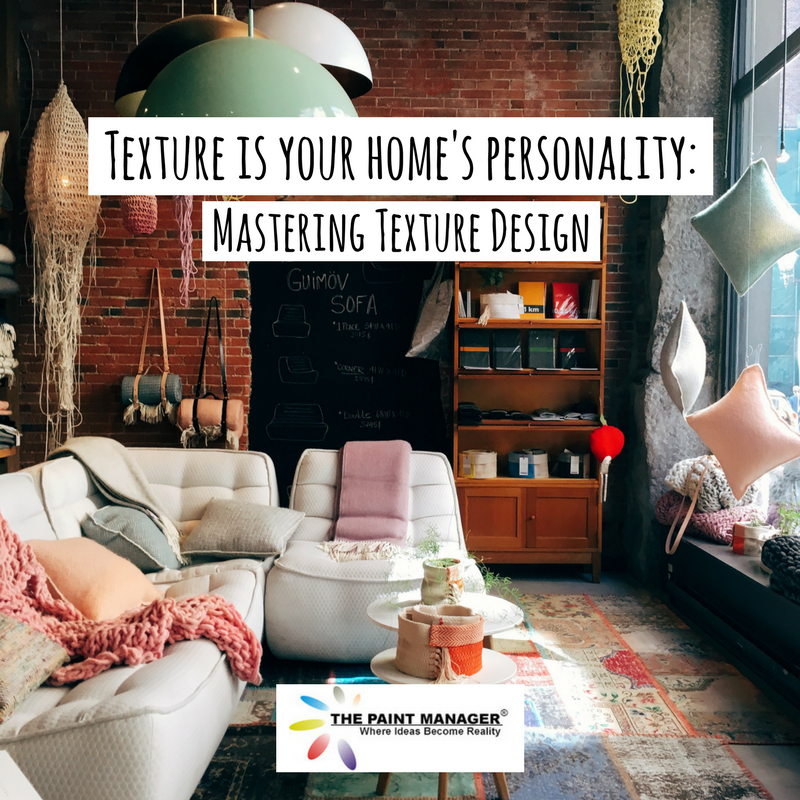Your home has everything: perfectly painted walls, nice furniture and relevant accessories. Yet, something still seems missing.
Still you come home from your friend’s with décor-induced jealously. What do they have that you don’t?
Texture design.
Texture is interior design’s response to personality. Uniform styling gives interior design an aesthetic, while differing elements found in knickknacks, plants, frames, fabrics breathe personality.
Not only does this create a physical depth for your home, it creates intrigues. By nature, humans are attracted to unlikely textures and pieces of furniture and decor that we can touch, taste or smell; When it comes to design, then, why not just give in to human nature?
Still not convinced? Consider this: texture is like adding jewelry and shoes to a nice dress. If your drive was nice before, now you have a complete outfit.
Make your home complete with textured interior design.
What is texture design?
Texture in designing spaces can either be tactile or visual. Tactile texture evokes a desire for touch, so that you are forced to feel an object in order to appreciate it. Visual texture is simply stimulating for the eyes. Either way, both elicit a physical reaction.
Take for example a sofa cushion. The cushion cover could be silky, embroidered, smooth, or woven, all of which have their own feel and their own emotion. Silky textures tend to create a more elegant emotion, while woven textures tend to elicit a more relaxed, cozy feeling.
In interior design, texture is generally the assimilation of fabric, metal, wood, ribbon or things with definitive patterns that are used to compliment multifaceted paints, wallpapers, flooring, lighting fixtures, tapestries, furniture, and accessories. Working together, these pieces make the space more interesting and appealing. There is texture in every aspect of interior design; you just have to find the ones that represent you.
Why does your home’s interior need texture?
When tactile elements are missing from an otherwise well-designed space, your room is bound to look bland, boring, or even cold and uninviting.
Texture is that part of a puzzle which, apart from dimension, adds a visual weight to the living space. Visual weight is explained by design experts as the “visual features of a room which compel you to take note of it”. It takes a perfectly designed room to the next level and binds your living space from top to the bottom.
Just as the right color scheme creates a feeling of warmth, textures can make your room look modern, intimate or rustic. For example, textures with glossy and smooth finish make your room look modern, while natural and rough textures bring out a cozier, more intimate feel.
With texture, placement is equally vital. Finding the right place for certain items will add subtlety to your space. For example, balancing a rough object next to a smooth one makes the latter stand out more than if you plan to put it at a distance. This makes placement and/ or distance a crucial factor. If something feels unbalanced or disproportionately mismatched, it probably is.
While textures are meant to be mixed, some do not play well with others.
Mix your metals, your picture frames, your couch pillows. If any of your textures are too similar, too matchy-matchy, these items will bore the eye. Just as mixing one polar opposite style of design with another (i.e. modern with rustic) will make the room feel crowded and uncomfortable.
How can you bring texture design to your space?
With the virtues of texture now established, let’s explore some ways you can add texture to any room in your home.
 1. Textured Furniture:
1. Textured Furniture:
Your furniture should the focal point of your room. It sets the tone for the overall feel.
Think of interesting finds: satin chairs, marble tabletop and/ or wooden worktops, and metal couch side tables.
2. Textured Flooring:
Rugs, carpets, wooden flooring or tiles- A perfectly placed rug can lend a lot of weight to the texture and vibe of the room. Shag rug for a cozy family room? Elegantly patterned rug for the dining room?
Definitive patterns of floor tiles or wooden flooring add credibility and interest to your space.
3. Textured Fabric:
Like rugs, using fabric in appropriate places like, pillows, slip  covers, window curtains, even the napkins on your dining room table can add levels of aesthetic interest. Patterned, quilted, or faux fur blankets are easy and understandably wonderful tactile texture to throw over a couch, chair, bench, or bed.
covers, window curtains, even the napkins on your dining room table can add levels of aesthetic interest. Patterned, quilted, or faux fur blankets are easy and understandably wonderful tactile texture to throw over a couch, chair, bench, or bed.
4. Textured Walls:
Paint, wall paper, and crown moldings are just the beginning of the texture of your walls. You could even consider the “exposed brick” look with paneling a wall with faux bricks.
Beyond that, gallery walls are texture’s best friend. In an intentionally disordered display, arrange a variety of picture frames, canvases, mirrors, and even wreaths to your walls. Gallery walls typically look best behind a couch or through a hallway.
5. Textured Accessories:
This gives you the opportunity for your knickknacks to show off your personality. Have a vintage, tin cigar box? Pair it with white, wide candles. Currently reading this Oprah’s book of the month? Strategically store it on a rustic tray on your ottoman. Need a place for your new Amazon Alexis speaker? Hide it next to potted plants or cacti. The possibilities are endless. These textures will tell the story of you.
Texture is more about striking a balance and getting the combinations right. This is the reason why you need to consult an expert when it comes to interior designing ideas. If you are based in Central Florida contact The Paint Manager for bringing personality to your room.
For great ideas and job satisfaction get in touch with The Paint Manager now.



